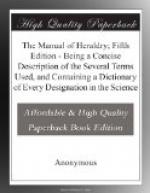VI.
The number of the points of mullets must be specified if more than five: also if a mullet or any other charge is pierced, it must be mentioned.
VII.
When a ray of the sun or other single figure is borne in any other part of the escutcheon than the centre, the point it issues from must be named.
VIII.
The natural colour of trees, plants, fruits, birds, &c., is to be expressed in emblazoning by the word proper; but if they vary from their natural colour, the tincture or metals that is used must be named.
IX.
Two metals cannot come in contact: thus or, cannot be placed on argent, but must be contrasted with a tincture.
X.
When there are many figures of the same species borne in coats of arms, their number must be observed as they stand, and properly expressed. The annexed arrangements of roundlets in shields will show how they are placed and described.
[Illustration: Two roundlets in pale]
[Illustration: Two roundlets in fess]
The two roundlets are arranged in pale, but they may appear in chief or base; or in fess, as in No. 2.
[Illustration: Three roundlets, two over one]
Three roundlets, two over one; if the single roundlet had been at the top, it would have been called one over two.
[Illustration: Three roundlets in bend]
Three roundlets in bend. They might also be placed in fess, chief, base, or in pale.
[Illustration: Four roundlets, two over two]
Four roundlets, two over two. Some armorists call them cantoned as they form a square figure.
[Illustration: Five roundlets in saltier]
Five roundlets; two, one, two, in saltier.
[Illustration: Five roundlets in cross]
Five roundlets; one, three, one, or in cross.
[Illustration: Six roundlets paleway]
Six roundlets; two, two, two, paleway.
[Illustration: Six roundlets in pile]
Six roundlets; three, two, one, in pile.
There are seldom more figures than seven, but no matter the number; they are placed in the same way, commencing with the figures at the top of the shield, or in chief. If the field was strewed all over with roundlets, this would be expressed by the word seme.
Marshalling coats of arms, is the act of disposing the arms of several persons in one escutcheon, so that their relation to each other may be clearly marked.




